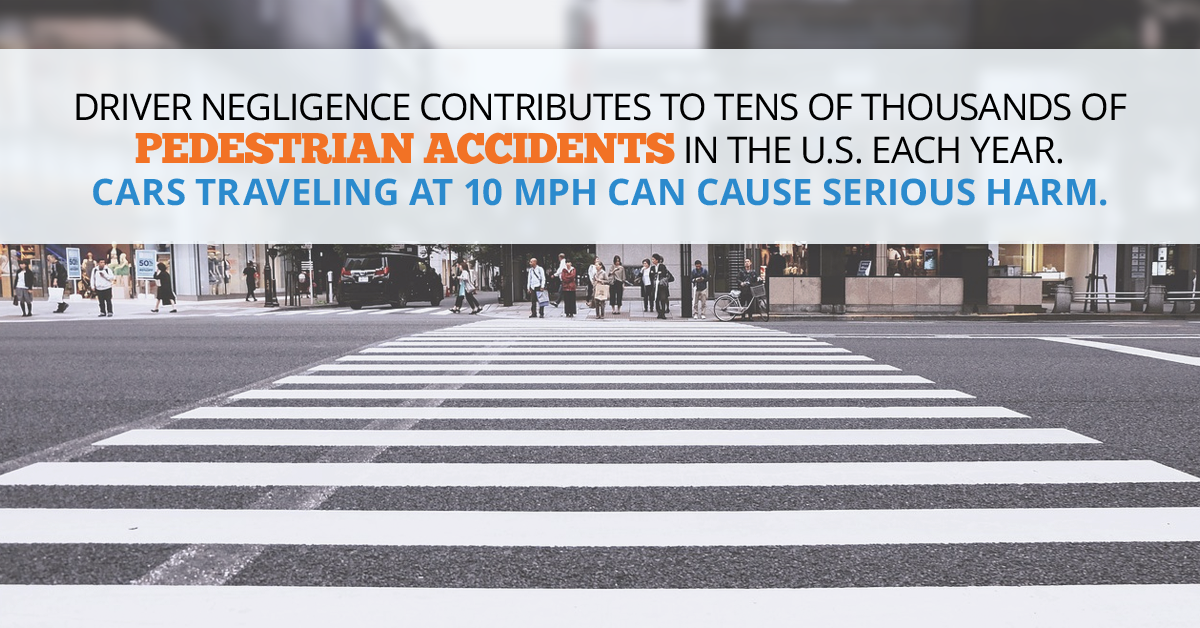Injuries Resulting from Pedestrian Accidents
- Lacerations
- Broken bones
- Paralysis
- Spinal cord injuries
- Head or neck injuries
- Concussion
- Traumatic brain injury
- Severed limbs
- Musculoskeletal injuries
- Chest and abdominal injuries
- Wrongful death
Pedestrian accidents occur when a person on foot suffers an injury in a collision with a motor vehicle, and due to their sheer size and weight, even passenger cars traveling at only 10 miles per hour can severely disable a pedestrian. Unfortunately, it can be difficult to recover damages for injuries sustained in a pedestrian accident, especially if you are unable to prove the driver’s negligence. If you or a loved one has suffered injuries in a pedestrian accident, consult a knowledgeable personal injury attorney as soon as possible to discuss your options for legal recourse. You may have grounds to file a claim against the driver found at fault in the accident, in order to seek fair and timely reimbursement for your losses.

There are a number of non-vehicular situations in which a pedestrian may suffer serious injuries, possibly due to a property defect or a poorly maintained sidewalk, for example. Most pedestrian accidents, however, occur when a person on foot — walking, jogging, running, hiking, sitting or lying down — is struck by a passing car or truck, usually while crossing the street or walking on the side of the road.
According to the National Highway Traffic Safety Administration (NHTSA), in 2012 alone, nearly 5,000 pedestrians were killed, and an estimated 76,000 were injured, in motor vehicle accidents in the United States — a six-percent increase from the number of pedestrians killed in traffic crashes the previous year. Even more alarming, more than one-fifth of the children ages 10 to 15 killed in traffic accidents in 2012 were pedestrians, meaning they were struck by a motor vehicle while on foot.
In 2012 alone, nearly 5,000 pedestrians were killed, and an estimated 76,000 were injured, in motor vehicle accidents in the United States.
Whatever the circumstances surrounding a pedestrian accident, the injured person may be entitled to financial compensation for medical bills and other related damages, if another person or party’s negligence caused or contributed to the accident. The term “negligence” has to do with the failure of a person to do (or not do) something that a reasonable person in a similar situation would, to protect others from foreseeable risks.
In other words, if a driver fails to stop at a crosswalk while pedestrians are crossing the street, and strikes a pedestrian, causing him or her to suffer injuries, the driver may be found negligent in the accident and can be held liable for the associated damages. To establish negligence in a pedestrian accident claim, the injured pedestrian, the “plaintiff,” must prove that the person at fault in the accident, the “defendant”:
It should be noted that pedestrians are also expected to exercise reasonable care for their own safety, in order to prevent an accident from occurring, and contributory negligence may be assessed against a pedestrian if he or she failed to exercise such care, and therefore contributed to the cause of his or her own injuries. Pedestrian negligence may include: ignoring the “don’t walk” signal at an intersection, darting in front of a moving vehicle, or failing to use marked crosswalks.
In an accident involving a motor vehicle and a pedestrian, the pedestrian is far more likely to suffer serious injuries than the driver or passenger car occupants. Young children are especially vulnerable to pedestrian accidents, due to their smaller size and lack of judgment regarding motor vehicles and oncoming traffic.
If you or a loved one has been injured in a pedestrian accident with a motor vehicle, contact an experienced personal injury lawyer today for legal help. You may be entitled to financial compensation for your injuries, medical bills, lost wages, emotional trauma, and other related damages, which you can pursue by filing a pedestrian accident claim against the person or party found at fault in the accident.